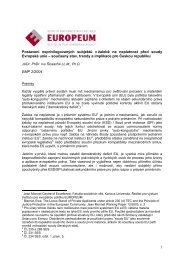eu constitutionalisation - EUROPEUM Institute for European Policy
eu constitutionalisation - EUROPEUM Institute for European Policy
eu constitutionalisation - EUROPEUM Institute for European Policy
Create successful ePaper yourself
Turn your PDF publications into a flip-book with our unique Google optimized e-Paper software.
Chapter 4: Government Coalitions and Institutional Re<strong>for</strong>m at the IGCavoid damaging its reputation <strong>for</strong> future negotiations, most notably th<strong>eu</strong>pcoming budget negotiations. That was, however, not the end of thecoalition. Once it was clear that the <strong>for</strong>mula would be changed from theNice, Spain and Poland continued to collaborate in raising the threshold ofpopulation and specifying the blocking minority requirement. FollowingSpanish-Polish insistence, the final Treaty includes a provision which specifiesthat a blocking minority must include at least four Council memberswhich ensured that the large three states alone – France, Germany and theUK – should not be able to block a proposal.In conclusion, the Spanish-Polish coalition emerged only towards theend of the Convention and became more visible only in the IGC. Regularmeetings and joint public statement display a high level of coordination ofstrategic actions in the coalition. It was built on shared – and in both casesintense – preferences over the QMV voting system combined with convergent,if not equally intense, preferences <strong>for</strong> the reference to Christianityand composition of the Commission (where they sided with the smallstates). Both countries also had similar aspirations on strengthening theirrole within EU politics. The shared interests and ideology, combined withmutually rein<strong>for</strong>cing power considerations (and to lesser extent strategicpreferences), best explain both countries’ choices <strong>for</strong> <strong>for</strong>ming a coalition.Although Spain acted as the initiator of the coalition it does not appear thatthere was asymmetry in decision-making within the coalition. Poland soonrose to an equal level partnership with Spain. During the IGC, the Spanish-Polish coalition sought to build tactical partnerships with the UK (on thedefinition of the QMV in exchange <strong>for</strong> support over the scope of QMV),and with the small countries (supporting one Commissioner per memberstate rule again in support <strong>for</strong> the Nice definition of QMV).The UKTraditionally, the UK has been at the <strong>for</strong>efront of the intergovernmentalistblock in the EU. Joined by Denmark and often Sweden, it has argued <strong>for</strong>the intergovernmental method of decision-making, distrusted towardssupranational integration, and envisaged the EU as an upgraded versionof a free trade area. However, the position of the UK within the EU hasbeen changing. With 1997 election of a new Labour government underPrime Minister Tony Blair, the UK began to seek a more active role in thecentre of the EU rather than playing the role of the sceptic ‘outer-ring’124Chapter 4: Government Coalitions and Institutional Re<strong>for</strong>m at the IGCmember.⁸³ What appeared to be a new British <strong>European</strong> strategy has hadpotential effects on the position of the Franco-German axis, and openednew opportunities <strong>for</strong> trilateral cooperation as well as other coalition constellationsinvolving the UK.The British government – although initially sceptical about a Conventionon a Future of Europe – prepared early and systematically to defend itsinterests. Although the British government cared about all the institutionalprovisions, its most important concern was the use of QMV in traditionallysensitive areas. In the White Paper published in September 2003 on the2003-04 IGC the Government stated: ⁸⁴‘In many areas, the use of majority voting has benefited the Britisheconomy. […] But we will insist that unanimity remain <strong>for</strong> Treatychange; and in other areas of vital national interest such as tax,social security, defence, key areas of criminal procedural law andthe system of own resources (the EU’s revenue raising mechanism).Unanimity must remain the general rule <strong>for</strong> CFSP, as proposed inthe final Convention text.’These points soon became known in the Convention as British ‘red lines’. Inorder to defend its ‘red lines’ British built a number of strategic partnershipswith various other governments concerned, mostly with the traditional alliesSweden and Denmark, but also with many of the new accession states. Thestrategic partnerships with the new accession states are particularly interesting.British understood that many of the prospective accession states mightbe sensitive on issues of sovereignty due to their recently acquired independenceand may well join the intergovernmentalist block. Since it had been verysupportive towards the enlargement, this provided a helpful foundation <strong>for</strong>potential future strategic relationships. Examples of this strategic partnership-buildingare well illustrated by the joint paper by Prime Minister Blairand Polish Prime Minister Miller on ‘The Future of Europe: Bringing Europecloser to its Citizens’ in 2001, ⁸⁵ and the joint article by Prime Ministers JuhanParts of Estonia and Tony Blair on ‘An enlarged Europe needs competition’published in 2003 in Financial Times.⁸⁶83) Smith and Tsatsas (2002).84) Foreign and Commonwealth Office London (2003).85) Blair and Miller (2001).86) Blair and Parts (2003).125








